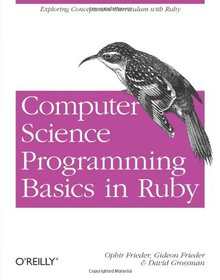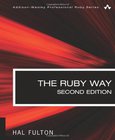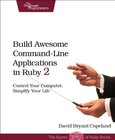Computer Science Programming Basics in Ruby

Book Details:
| Publisher: | O'Reilly Media |
| Series: | OReilly |
| Author: | Ophir Frieder |
| Edition: | 1 |
| ISBN-10: | 1449355978 |
| ISBN-13: | 9781449355975 |
| Pages: | 188 |
| Published: | May 01 2013 |
| Posted: | Nov 19 2014 |
| Language: | English |
| Book format: | |
| Book size: | 7.64 MB |
Book Description:
If you know basic high-school math, you can quickly learn and apply the core concepts of computer science with this concise, hands-on book. Led by a team of experts, youamp;#8217;ll quickly understand the difference between computer science and computer programming, and youamp;#8217;ll learn how algorithms help you solve computing problems. Each chapter builds on material introduced earlier in the book, so you can master one core building block before moving on to the next. Youamp;#8217;ll explore fundamental topics such as loops, arrays, objects, and classes, using the easy-to-learn Ruby programming language. Then youamp;#8217;ll put everything together in the last chapter by programming a simple game of tic-tac-toe.Learn how to write algorithms to solve real-world problems Understand the basics of computer architecture Examine the basic tools of a programming language Explore sequential, conditional, and loop programming structures Understand how the array data structure organizes storage Use searching techniques and comparison-based sorting algorithms Learn about objects, including how to build your own Discover how objects can be created from other objects Manipulate files and use their data in your software
Download Link:
Related Books:
The Ruby Way
Solutions and Techniques in Ruby Programming
2nd Edition
Ruby is an agile object-oriented language, borrowing some of the best features from LISP, Smalltalk, Perl, CLU, and other languages. Its popularity has grown tremendously in the five years since the first edition of this book. The Ruby Way takes a 'how-to' approach to Ruby programming with the bulk of the material consisting of more than 400 examples arranged by topic. Each example answers the question 'How do I do this in Ruby?' Working along with the author, you are presented with the task description and a discussion of the technical constraints. This is followed by a step-by-step presentation of one good solution. Along the way, the author provide...
Build Awesome Command-Line Applications in Ruby
Control Your Computer, Simplify Your Life
Speak directly to your system. With its simple commands, flags, and parameters, a well-formed command-line application is the quickest way to automate a backup, a build, or a deployment and simplify your life. As Ruby pro David Copeland explains, writing a command-line application that is self-documenting, robust, adaptable and forever useful is easier than you might think. Ruby is particularly suited to this task, since it combines high-level abstractions with "close to the metal" system interaction wrapped up in a concise, readable syntax. Moreover, Ruby has the support of a rich ecosystem of open-source tools and libraries. Ten insightful chapters each explain and demonstrate a command-line best practice. You'll see how to use these too...
Build Awesome Command-Line Applications in Ruby 2
Control Your Computer, Simplify Your Life
Speak directly to your system. With its simple commands, flags, and parameters, a well-formed command-line application is the quickest way to automate a backup, a build, or a deployment and simplify your life. With this book, you'll learn specific ways to write command-line applications that are easy to use, deploy, and maintain, using a set of clear best practices and the Ruby programming language. This book is designed to make any programmer or system administrator more productive in their job. Now updated for Ruby 2.Writing a command-line application that's self-documenting, robust, adaptable and forever useful is easier than you might think. Ruby is particularly suited to this task, because it combines high-level abstractions with "close to ...
2007 - 2021 © eBooks-IT.org



